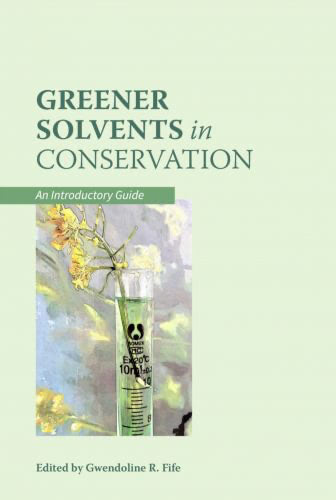Published in association with Sustainability in Conservation (SiC) and Archetype publications.
Sponsored by Tru Vue.
The Necessity
Like all sectors conservation needs to move towards more environmentally responsible practices, and in this regard, the increasing variety of specifically developed materials, alongside others available to the modern conservation practitioner, can be undoubtedly beneficial. However, there remain certain common conservation treatments where solvent use cannot be avoided.
Hence, after an initial assessment by the conservator as to whether such a solvent-based treatment (and thus any solvent use) is necessary in the first place, a next most impactful action is identifying and eliminating the most toxic, environmentally hazardous solvents from their practice. Aligning with long-standing practice in many conservation studios the industrially-termed Greener Solvent Alternatives approach can be applied, wherein greener substitute solvents (or mixtures) are determined to replace those solvents in use which have greater health or environmental concerns. Since certain traditional solvents and mixtures already present a relatively greener solution, and others warrant replacement as soon as possible, there is a primary need to clarify this assessment and approach. By prioritising the removal and replacement of the most harmful solvents that may be presently used in conservation, a greener solvent approach already presents a highly beneficial action for both conservators and the world. But, given our currently critical climate situaton we only need to look slightly ahead to see that the effect of broader legislations coming into force means that certain traditional solvents previously tested and relatively trusted for use on art works, will become unavailable or economically unviable. Suddenly a greener solvent approach then becomes one of necessity rather than choice.

Additional Challenges
This pressing need poses a major problem within conservation, since appropriate solvent implementation within our treatment applications can be complex. Requiring specialist knowledge and dependent on discipline, solvent selection needs to consider not only how solvents will interact with the planned conservation materials, but also how they might potentially affect the materials in the original substrate, as well as their impact on human health and the environment. Since any one of these aspects can be a complicated story in itself, the incorporation of greener solvent approaches in conservation practice can appear a challenging and even overwhelming objective.
Introducing direct replacements (where these are needed) with newly developed or novel substitute greener solvents, is also less straightforward for conservation than in many other industries. Valid appraisals require both analytical and empirical approaches, and in-depth scientific research into the potential short and longer-term effects of these solvents on original substrates is needed to provide this key information in any balanced risk assessment. Lacking this information, conservation faces being blind-sided by enforced changes.

The Solutions
To accomodate an ever greater need for research and reliable information regarding appropriate replacements SiC’s Greener Solvents project was therefore conceived as an international collaborative research project providing accessible resources for promoting and disseminating greener solvent research and supporting conservators in their safe and correct implementation of greener solvent approaches.
The first deliverable outcome of this project is the expert-reviewed handbook, ‘Greener Solvents in Conservation: An Introductory Guide’, edited by G.R. Fife, recently published by Archetype Publications (2021). This provides supporting information regarding the history of greener solvents together with assessment methods for their definition (e.g. life cycle assessments/safety, health and environment ratings). The handbook clarifies the comparative nature of their identification, and provides insights into the potential and safe application of greener solvents (both traditional and modern) within the conservation field for both the practitioner and artwork. Moreover, practical step-by-step guidelines are included to help conservators identify and eradicate in the first instance, their use of the worst solvent offenders, and outlines the most straightforward ways to determine the alternatives (ideally already available in the studio) that may be implemented in their place. Given that for many conservators time and budgets are stretched, this can also provide a convincing approach for those who understandably wish to limit the introduction of frequent adaptations in their practice. The handbook also provides insights into where novel replacement solvents are critically needed in conservation, information particularly beneficial regarding the allocation of valuable further research time and resources.
Made freely available on SiC’s website this handbook is an important first step in the project’s goal to provide streamlined open-access information for conservators in implementing the use of greener solvent approaches, and help conservation transition into a more environmentally responsible field.
The handbook, as well as more information about the ongoing project can be found on SiC’s website. A hard copy Greener Solvents Handbook: An Introductory Guide is also available from Archetype.
Share this Article:
This article is intended for educational purposes only and does not replace independent professional judgment. Statements of fact and opinions expressed are those of the author(s) individually and, unless expressly stated to the contrary, are not the opinion or position of Tru Vue or its employees. Tru Vue does not endorse or approve, and assumes no responsibility for, the content, accuracy or completeness of the information presented.
